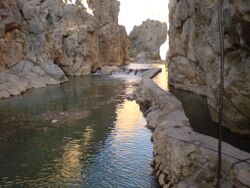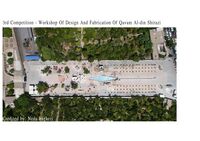LED 2016 Group E Landscape Democracy Challenge 1
Please add the title of your case study here and replace the dummy image with a characteristic image of your site
| Place name | Beheshtabad River | |
| Location | Chaharmahal va Bakhtiari | |
| Country | Iran | |
| Author(s) | Sanaz Emamverdi | |

| ||
Rationale: Why have you chosen this case for the landscape and democracy seminar?
- Why is this case relevant?
- brief explanation in essay style , approx 150 words
According to the Beheshtabad project, it was planned to transfer 500 million cubic meters water of this river (one of the Karun’s branch) to three other central provinces. The project includes 65 km tunnel which has been drilled in depth of 300-500 meters. In fact, all the transferring water projects were implemented to fetch drinking supply. Because the supply of drinking water is a good excuse to convince public opinion that the government has to do to provide drinking water. Therefore, the demand for drinking water cannot be objected. While it seems Beheshtabad water is planned for agriculture and industrial aims. The main goal of this project is to provide the agriculture and industrial water of the three other states, while in many areas in this state, people are suffering from the lake of drinking water. The project started more than 5 years ago. However, in the destination of the tunnel the construction of equipped workshops had been begun, in the source part in Chaharmahal va Bakhtiari the construction has been halted due to the protests. Local people with the support of provincial authorities protested against the project. Consequently, the government decided to postpone the project.
Representation of your observations
- you are basically free to use one or a mix of different presentation techniques
- possibilities are: analytical drawings, graphical representations, collages, video clips, comic/graphic novel, written essay/visual essay
- please add any visual material to the gallery, videos can be placed below, you may add text as you like
- Yourfilename4.jpg
case representation
Reflection
What are the major challenges for changing the situation?
- Please add approx. 150 words in essay style
One of the major challenges for this project is that by constructing these tunnels, aquifers in the direction of the tunnels will be damaged and endangered people’s settlement, which can cause serious damages to agricultural lands and therefore these fields will be dried in the future. On the other hand, this plan can decrease the amount of flowing water to the Karun River, which can cause the similar problems for the Khuzestan province. Moreover, people in Khuzestan faced the shortage of drinking water, which in this situation constructing such a project can make the living’s condition even worse. Another goal of this project was to revive the Zayanderood (in Isfahan), which is not a good solution to revive another area by making this high percent of risk and environmental damages to another area. This project not only will not help the Zayanderood but also it will create irreparably economical, social and environmental damages.
What could be a starting point for democractically-based change?
- Please add approx. 150 words in essay style
People and authorities do not oppose the construction of dams or transferring the extra water to provide drinking water. But they disagree to unprofessional solutions or projects to transfer the water which can cause economical, social and environmental damages. Then, government can consider the human justify and preserve the environment for the future, by providing the appropriate research and using professional experts to find the reasonable solutions.
References
- ...
- ....
- ...
- Please make sure that you give proper references of all external resources used.
- Do not use any images of which you do not hold the copyright.
- Please add internet links to other resources if necessary.
About categories: You can add more categories with this tag: "", add your categories


